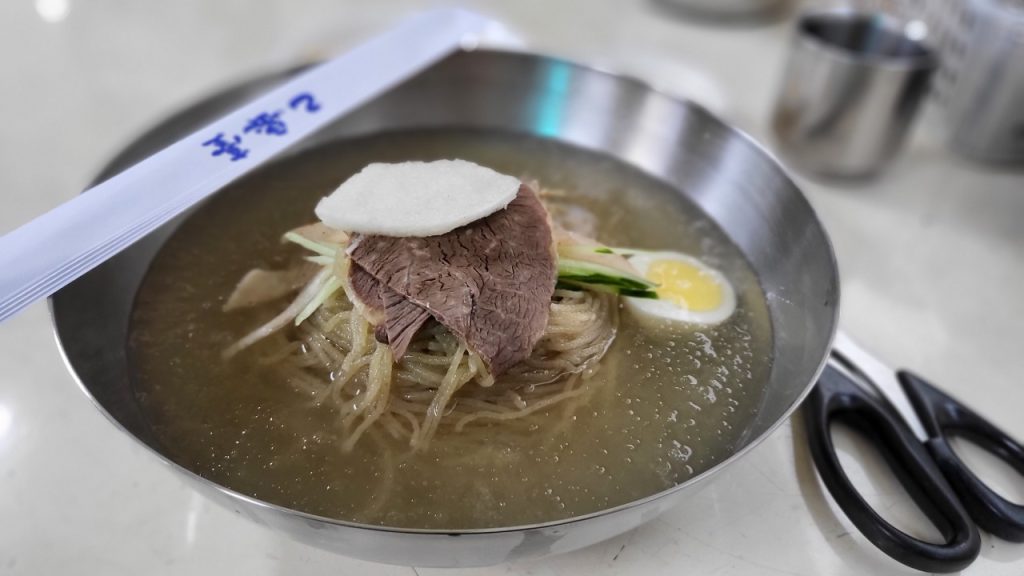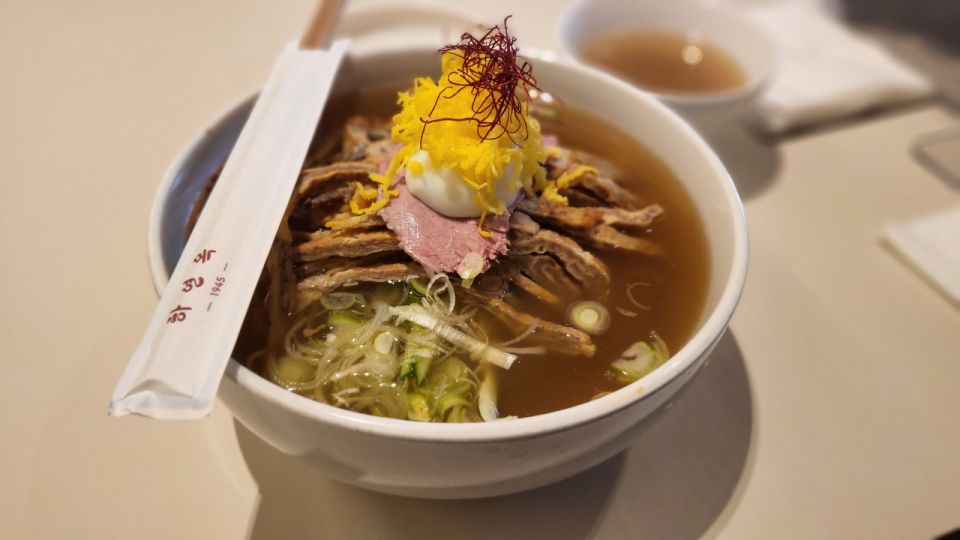January 10, 2022
The four seasons of Korea are distinct, which led to the development of seasonal dishes depending on which ingredients that were fresh and available at the time.
Naengmyeon, cold noodles served in broth usually made of beef stock, is an exception. The popular Korean cold noodle dish sharpens the appetites of noodle lovers not only in the summer, but also during the height of the winter season. In fact, some naengmyeon lovers will swear by slurping icy cold noodles while seated on a warm ondol floor.
The origin of naengmyeon dates back to the Joseon era, and is documented in “Gonggukesigi,” a book on traditional customs of Korea in 1849. The first two types of naengmyeon sprouted from North Korea’s Pyongyang and Hamhung and later landed in South Korea after the end of the Korean War.
Naengmyeon has often been highlighted at banquets during inter-Korean summits, including North Korean leader Kim Jong-un’s invitation of President Moon Jae-in and First Lady Kim Jung-sook in 2018 to Okryugwan, Pyongyang’s top naengmyeon restaurant.
The event sparked a “naengmyeon craze” in South Korea, with people flocking to famous Pyongyang naengmyeon spots around the country.
“Naengmyeon is a food of bare face without any makeup, neither too salty nor too sweet, and is the most difficult among our (Korean) foods to make,” restaurateur and entertainer Paik Jong-won said during a cooking TV show, noting the contrast between the complexity of making the dish and its humble appearance.
Here is a beginner’s guide to understanding the basic differences of the three representative types of naengmyeon — Pyongyang, Hamhung and Jinju naengmyeon. — and the restaurants dedicated to them.
Pyongyang naengmyeon: Eulmildae

Pyongyang naengmyeon (Kim Hae-yeon/ The Korea Herald)
Pyongyang naengmyeon at Eulmidae consists of buckwheat noodles in dongchimi, clear broth of radish kimchi, with beef slices, julienned cucumber, slicked of pickled radish and a halved boiled egg as garnish on top. The dongchimi poured on top is the essence of naengmyeon that defines the true taste of the dish.
Opened in 1970, Eulmildae is located in a small alley of Seoul’s Mapo district. There is a witty saying among Koreans that, “When young, you will not understand what makes the bland taste of Pyongyang naengmyeon so special.” The restaurant is usually crowded with middle-aged or senior visitors. When you notice young visitors having naengmyeon alone in a winter day, you are safe to hazard a guess that they are epicures. At Eulmildae, diners can order suyuk, a boiled beef dish made with brisket, which also pairs well with soju.

Pyongyang naengmyeon restaurant Eulmildae (Kim Hae-yeon/ The Korea Herald)
Hamhung naengmyeon: Ojangdong Hamheung Naengmyeon

Hamhung naengmyeon (Kim Hae-yeon/ The Korea Herald)
Hamhung naengmyeon is made of long, thin noodles with spicy red pepper sauce, with similar garnishes as Pyongyang naengmyeon.
Hamhung is located on the eastern coastal city of North Korea, and it is said that the spicy version of naengmyeon was created to endure against the cold. The dish later traveled to Busan with refugees from Hamhung, and became what we call milmyeon today.
The chewy texture of the noodles — a mixture of buckwheat, potato starch and sweet potato starch — sets Hamhung naengmyeon apart from others. Although the servers bring scissors to the table, Hamhung naengmyeon lovers would protest against any cutting in order to fully enjoy the unique texture.
Ojangdong Hamheung Naengmyeon is a family owned restaurant in Jung-gu, central Seoul, established in 1953. The place was selected as “Seoul Future Heritage” by Seoul City in 2013, and has also been included on Michelin’s Bib Gourmand list since 2017.
Thin beef slices are put on top, but in other Hamhung naengmyeon restaurants, slices of raw fish are often served as a topping instead of meat. A five-piece set of steamed large dumplings is commonly enjoyed as a side dish.

Hamhung naengmyeon restaurant, Ojangdong Hamheung Naengmyeon (Kim Hae-yeon/ The Korea Herald)
Jinju naengmyeon: Hayeonok

Jinju naengmyeon restaurant Hayeonok (Kim Hae-yeon/ The Korea Herald)
Although Jinju naengmyeon is the least well known of the three, the rich complexity in the taste of its broth is on par with other representative noodle dishes in Korea.
Jinju naengmyeon comes from Jinju, South Gyeongsang Province. Its unique feature is the garnish — slices of yukjeon, or pan-fried beef slices coated in batter. Jinju naengmyeon’s seafood-based broth also sets it apart from other naengmyeong.
The restaurant Hayeonok started 1945 in Jinju, and currently has two branches in Seoul, one in Hongdae, and the other in Jamsil. The Hongdae branch has a modern and cozy interior with one-person bar seats. A special menu called Geookmyeon is on the menu, named after Ha Geo-ok, who first opened the restaurant. If you order a separate yukjeon dish, yukgaejang, spicy beef hot soup with vegetables are provided on the house.


